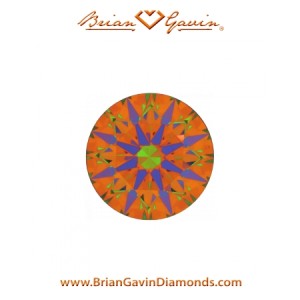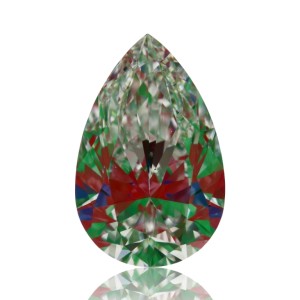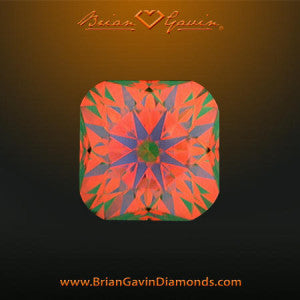
Pear shape vs. Round brilliant cut diamonds
“My girlfriend has expressed an interest in either a pear shape or round brilliant cut diamond. Which diamond shape is going to offer better sparkle? We’ve looked at both shapes in some local jewelry stores, but the polish and symmetry ratings were only good to very good. So they probably didn’t offer the best sparkle, but the diamonds looked pretty good. One concern that she expressed is that she doesn’t like the dark bowtie effect, which seemed pretty distinct on the pear shape diamonds that we’ve seen thus far. Is the bowtie effect something which is eliminated with higher cut quality? Which is going to sparkle more? A pear shape or brilliant cut diamond?”
Let’s talk about that bowtie effect:
This photograph is of a 1.01 carat, D-color, VS-2 clarity, pear shape diamond which is graded by the GIA as having excellent polish and symmetry. It’s a really nice looking diamond as far as pear shape diamonds go. The bowtie effect is truly very minimal. There is always going to be a bowtie effect in pear shape diamonds to some extent. It is created by the difference in light being reflected by the long and short pavilion facets, which are located on the lower half of the diamond. The bowtie effect appears at the junction point where those longer and shorter facets come together. Better proportions and symmetry tend to reduce the appearance slightly.
What diamond shape offers the best light performance?
 I think that what you’re really asking is what diamond shape offers the best light performance? A pear shape or round brilliant cut diamond. Assuming that both diamonds have been cut to the best proportions and optical precision, the round brilliant is still going to win out every time. This is largely due to the symmetrical, round facet structure. This is the ASET scope image for this 1.024 carat, D-color, VS-2 clarity, Brian Gavin Signature round diamond. Notice how there is a lot of red (indicating incredible brightness) and that the green areas are evenly distributed throughout the diamond. The blue which represents contrast is also evenly distributed.
I think that what you’re really asking is what diamond shape offers the best light performance? A pear shape or round brilliant cut diamond. Assuming that both diamonds have been cut to the best proportions and optical precision, the round brilliant is still going to win out every time. This is largely due to the symmetrical, round facet structure. This is the ASET scope image for this 1.024 carat, D-color, VS-2 clarity, Brian Gavin Signature round diamond. Notice how there is a lot of red (indicating incredible brightness) and that the green areas are evenly distributed throughout the diamond. The blue which represents contrast is also evenly distributed.
This is a text book example of what an exceptionally crafted round brilliant super ideal cut diamond should look like when viewed through an ASET Scope. Which is a diamond diagnostic tool that was developed by the American Gem Society Laboratory (AGSL) to measure and evaluate the light performance of diamonds.
Using ASET to Evaluate Pear Shape Diamond:
 This is the ASET scope image provided for the 1.01 carat, D-color, VS-2 clarity, pear shape diamond referenced above, which has excellent polish and symmetry. There is a concentration of red in the middle section of the diamond, which indicates that region of the diamond will be very bright. And there is a fair amount of green, and some contrast… but there is also a lot of clear, see-through, translucent areas, and that my friend, is an indication of light leakage. Now the reality is that this diamond is truly a great example of a pear shape diamond that has been cut truly well. It’s just that this particular shape of diamond tends to look this way…
This is the ASET scope image provided for the 1.01 carat, D-color, VS-2 clarity, pear shape diamond referenced above, which has excellent polish and symmetry. There is a concentration of red in the middle section of the diamond, which indicates that region of the diamond will be very bright. And there is a fair amount of green, and some contrast… but there is also a lot of clear, see-through, translucent areas, and that my friend, is an indication of light leakage. Now the reality is that this diamond is truly a great example of a pear shape diamond that has been cut truly well. It’s just that this particular shape of diamond tends to look this way…
People who like pear shape diamonds, must simply accept that this is more or less, the nature of the beast. There are going to be pear shape diamonds like this one, which exhibit a minimal bowtie effect, and leak a bit of light… especially as compared to a Brian Gavin Signature round hearts and arrows diamond. That doesn’t make them bad or less desirable, it just makes them different. Just like a Dalmatian is different than a German Shepherd.
 Which breed of dog you decide to adopt, or which shape diamond you decide to buy, will at some point come down to your personal preferences. But if light performance is a factor in your decision process, then you’re likely to buy the round. At least until the day when Brian Gavin decides to design a better performing pear shape diamond (which I’m not saying he’s going to do) as he did with the Brian Gavin Signature Cushion cut diamond. I mean, just look at how fantastic the ASET Scope image looks for this 1.024 carat, E-color, VVS-1 clarity, Brian Gavin Signature cushion cut diamond appears. When Brian Gavin redesigns a diamond shape, he rocks it!
Which breed of dog you decide to adopt, or which shape diamond you decide to buy, will at some point come down to your personal preferences. But if light performance is a factor in your decision process, then you’re likely to buy the round. At least until the day when Brian Gavin decides to design a better performing pear shape diamond (which I’m not saying he’s going to do) as he did with the Brian Gavin Signature Cushion cut diamond. I mean, just look at how fantastic the ASET Scope image looks for this 1.024 carat, E-color, VVS-1 clarity, Brian Gavin Signature cushion cut diamond appears. When Brian Gavin redesigns a diamond shape, he rocks it!
















